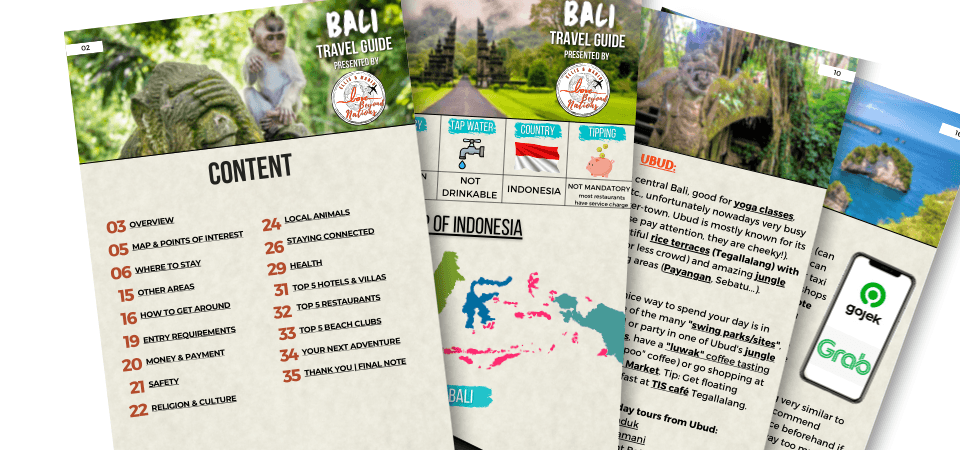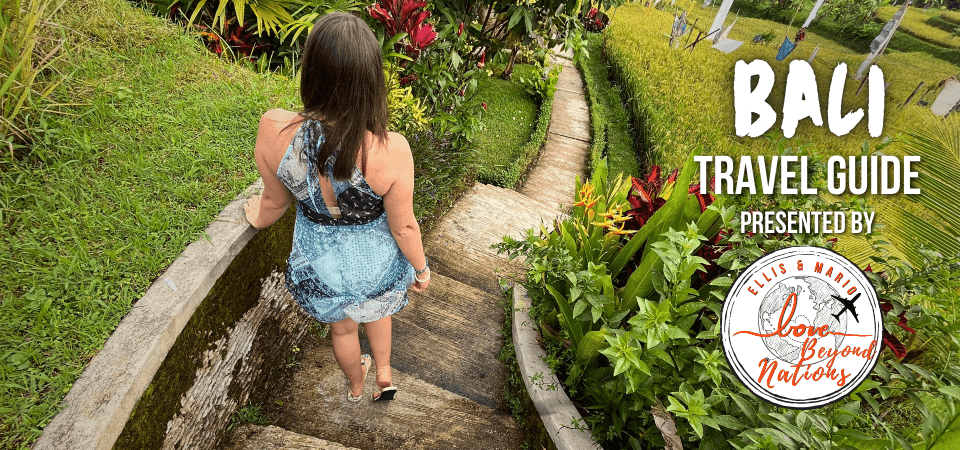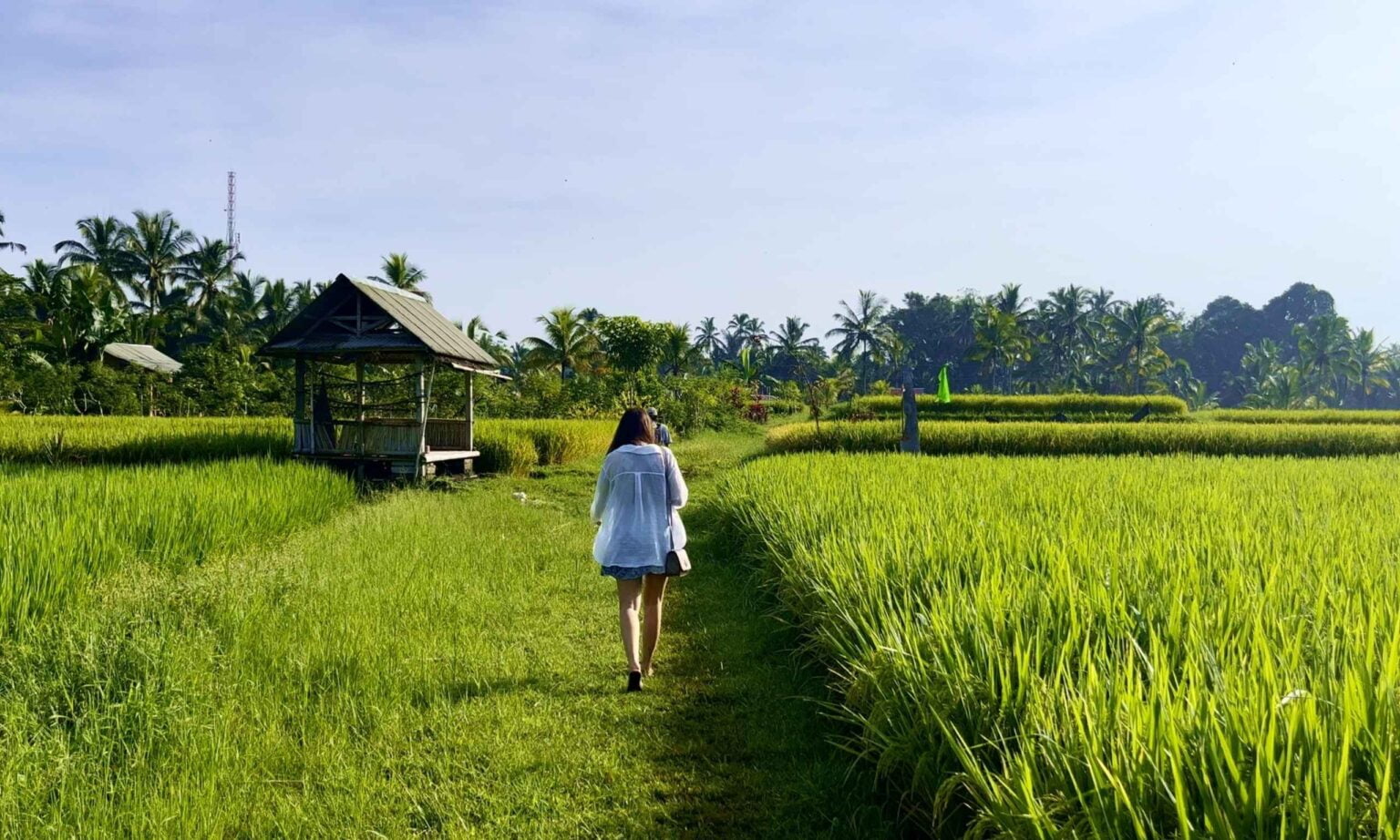
Our Bali Story – From Never Again to Pure Magic
This is our Bali Travel Guide 2025, built on everything we have learned since those first days and everything that has changed since 2019. Inside you will find realistic costs in IDR, the latest on visa and immigration rules, tips on the best time to visit, safe beaches for swimming, safety basics, sustainability advice, and itineraries from one to seven days. Use the lits to jump to any section and do not forget to bookmark this guide, because we update it regularly.
But lets start a little while back. We almost wrote Bali off in 2019. After ten dusty days in Seminyak we said we would not return. But we did. Six months of mornings in Uluwatu, quiet nights in Sidemen, waves in Canggu, and road trips through the north showed us what Bali truly is. It is breathtaking, imperfect, and worth careful planning.
⚠️ Affiliate Disclosure: This article contains affiliate links. If you book through them, we may earn a small commission – at no extra cost to you. Thank you for supporting Love Beyond Nations.
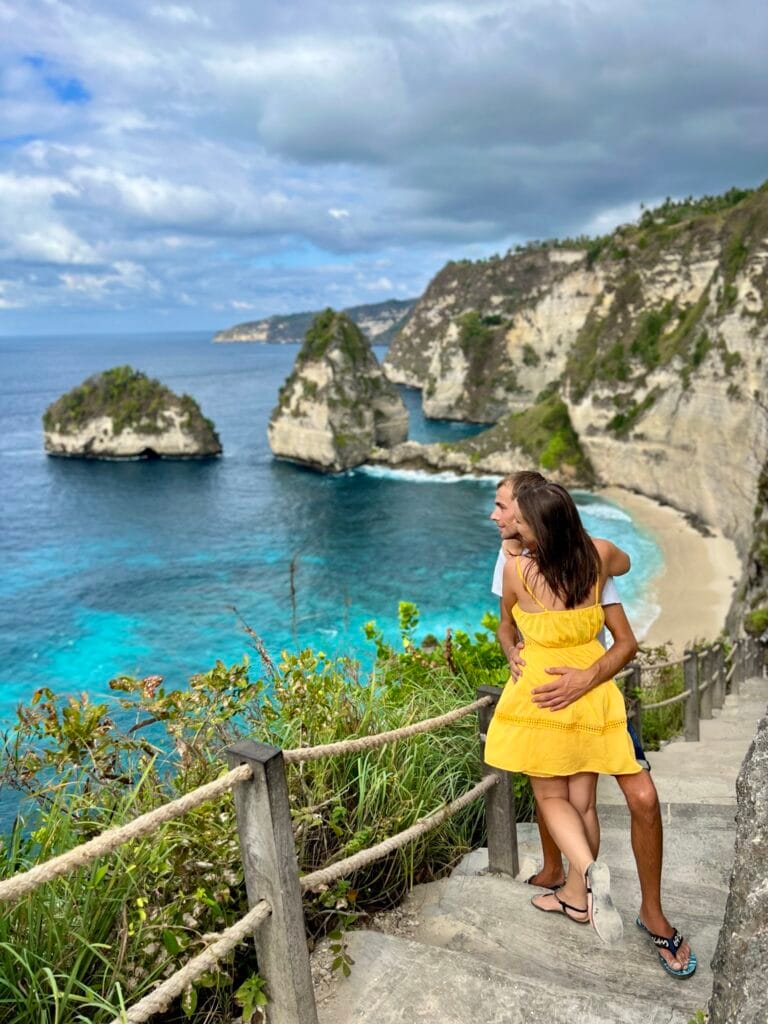
Quick Facts – Bali Travel 2025
• Backpacker: 600,000 to 900,000 IDR (€35 to 55)
• Mid-range: 1,400,000 to 2,200,000 IDR (€82 to 130)
• Luxury: 3,500,000+ IDR (€200+)
Visa rules and prices can change; please double check before you fly.
Is Bali Still Worth Visiting in 2025?
Bali in 2025 feels very different from 2019. Canggu grew from a quiet surf village into an international hub filled with coworking spaces, craft coffee, and new apartments. Uluwatu shifted from surfer secret to global stage. The cliffs still rise raw against the sea, and turquoise water invites you to swim in bays like Padang Padang and Melasti when the tide is calm. Ubud still holds the island’s spiritual heartbeat. Its center pulses with yoga studios, markets, and boutique hotels, while just a few kilometers out you can wander quiet rice valleys, stumble on waterfalls, and watch offerings laid on doorsteps at dawn.
Sidemen remains the slowdown choice. Mornings here begin in silence among the rice fields with Mount Agung rising in the distance. The north still feels calm, with eco lodges hidden in jungle valleys and waterfalls waiting for early risers. Yet change is coming as new roads from Canggu push further north. Nusa Penida, once a hidden gem, has become a crowded adventure stop. Its raw beauty survives, but it takes timing and patience to find it. Bali’s appeal lies in this duality. It can be loud and chaotic one moment and quiet and peaceful the next, offering both nightlife and spirituality in a single journey. Knowing where to go and when makes all the difference in 2025.
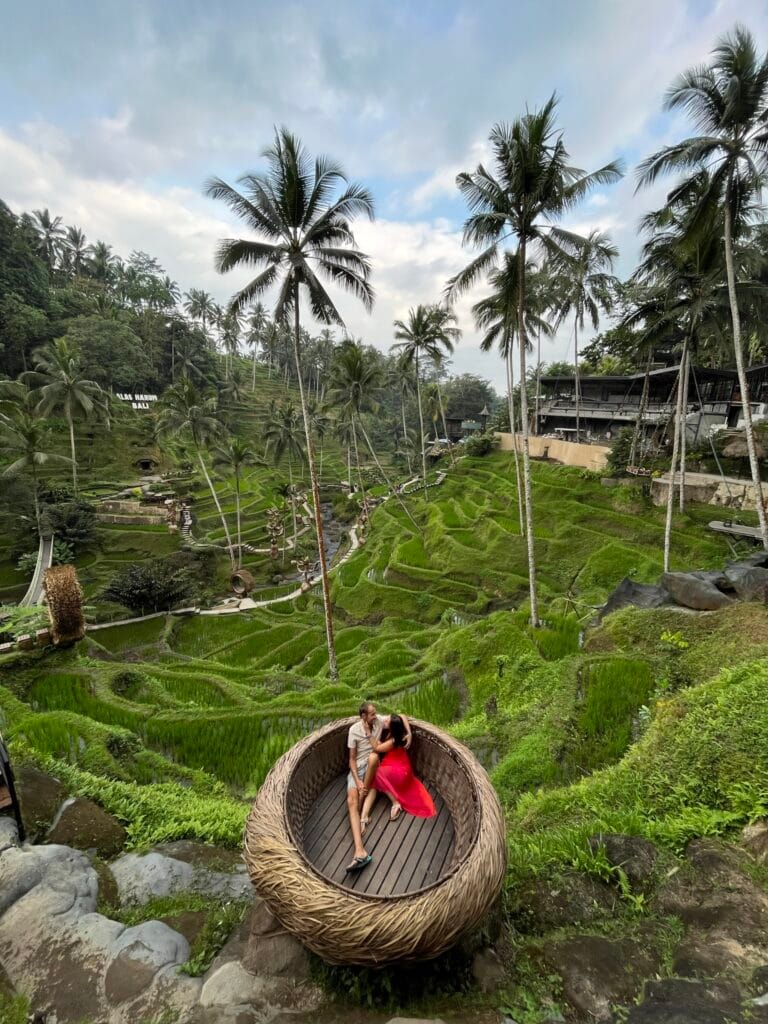
Visa entry rules 2025 for Indonesia
From September 1, 2025, the All Indonesia Arrival Card is mandatory for travelers arriving in Jakarta, Bali, and Surabaya.
From October 1, 2025, it applies at all international airports nationwide, replacing separate immigration, customs, and health forms.
Complete it online within 72 hours before your flight, save the QR code, and present it at entry.
If you do not complete it in advance, terminals are available on arrival—but queues are common and processing takes longer.
Official portal: allindonesia.imigrasi.go.id.
The most common options for visitors are below. Always verify details before you fly.
30 days. Official fee IDR 500,000 (~€30). Buy at the airport or online as e-VOA (official).
Extend once for +30 days. Extension fee IDR 500,000 at immigration; agents may add a service fee. See details in the official e-Visa FAQ.
Prearranged single entry: 60 days initial stay, extendable 2× for 60 days each (up to 180 days). See the B211A FAQ (official).
Requirements
- Passport valid 6+ months from arrival
- Proof of onward/return ticket may be requested
- Proof of funds may be requested for some visit visas (see B211A FAQ)
- Travel insurance strongly recommended
Bali Tourist Levy
One-time IDR 150,000 levy per entry. Pay in advance and carry the QR code: Love Bali — Official | FAQ
All-Indonesia Arrival Card (Immigration + Customs + Health)
- Complete online within 72 hours before arrival; a QR code is issued.
- Official portal (web & app): allindonesia.imigrasi.go.id
- Rollout: from 1 Sep 2025 at Jakarta (CGK), Bali (DPS), Surabaya (SUB); mandatory nationwide from 1 Oct 2025.
- If not completed pre-arrival, you can fill it on entry (QR stands in terminal) — expect delays.
Airport Steps at DPS (Ngurah Rai)
- Show All-Indonesia Arrival Card QR at CIQ checkpoints (retrieve QR).
- VOA/e-VOA verification at Immigration (official page).
- Baggage claim; proceed to exit. (Legacy standalone e-CD no longer required when using All-Indonesia.)
- Tourist levy check: show your Love Bali QR.
Pro Tips
- Screenshot your Arrival Card QR, e-VOA, and levy QR for offline access.
- Late-night arrivals to Ubud/Canggu: pre-book a driver.
🔎 Official sources linked above. Last checked: 1 Sep 2025. Rules and fees can change; verify before departure.
Getting Around – What Actually Works
We’ve tested almost every option, from haggling with taxi drivers at the airport to riding scooters through rice-field shortcuts. How you move on the island defines how you experience it. Distances look short on the map, but traffic, winding roads, and sudden ceremonies that close entire streets mean that transport is always part of the adventure.
Scooters – freedom with a learning curve
Scooters are by far the most flexible way to explore. Day one can feel overwhelming with left-hand traffic, honking horns, dogs darting across the road, and potholes you only see at the last second. By day three the chaos clicks into rhythm and you’ll find yourself gliding between rice paddies at sunset, grinning inside your helmet.
Cost: 75.000 IDR/day (~€5), cheaper for long-term rentals.
Tips: Always wear a helmet, closed shoes beat flip-flops, and don’t skip travel insurance that covers scooter accidents. If you’ve never ridden before, take a practice loop around quiet village streets first.
📝 Ellis’ Note: The island’s #1 tourist injury is scooter crashes. Avoid night riding in heavy rain and never ride under the influence of alcohol or drugs — main roads are not shortcuts.
Grab & Gojek – cheap, easy, lifesavers on rainy nights
Both apps are Bali essentials, covering motorbike taxis, car rides, and food delivery.
- Gojek: usually cheaper for short hops in Ubud, Canggu, or Denpasar; fast ojeks (motorbike taxis) dodge traffic.
- Grab: more reliable for airport pickups or longer distances, with upfront pricing and better car availability.
💡 Pro tip: Always pin your pickup point to a clear landmark (like a minimart) to help your driver find you quickly.
Bluebird Taxis – old school, still trustworthy
Bluebird is the official metered taxi brand. The cars are air-conditioned, licensed, and reliable. Because “fake Bluebirds” exist, download the Bluebird app and order directly through it.
Private drivers – best for day trips and families
For waterfall circuits, temple days, or carrying heavy luggage, nothing beats hiring a driver.
Cost: 600.000–700.000 IDR/day (~€40) for 8–10 hours including fuel.
Why it’s worth it: local knowledge, backroad shortcuts, no stress about parking or police stops. Families especially find this easier than multiple scooters.
Booking: Ask your hotel, a trusted contact, or via ride-hailing apps (many drivers offer fixed daily rates).
Reality check: traffic shapes every itinerary
- Ubud: Narrow streets clog daily from ~15:30–19:00. Plan to be back by late afternoon or choose dinner spots within walking distance.
- Canggu & Pererenan: Rush-hour traffic is notorious; a 3 km ride can take 30 minutes. Start early for beach days.
- Uluwatu: Scenic but hilly roads with long stair descents to beaches like Melasti or Padang Padang. Budget energy for the climb back up.
⚠️ Attention: Bali traffic can turn short distances into long journeys. Always add buffer time if you have flights, ferries, or fixed tours.
Quick Overview of Transport Costs in Bali (2025)
Quick Overview of Transport Costs in Bali (2025)
-
🛵Scooter~ 75.000 IDR/day (~€5)Best for: Freedom, solo & couples with experience
-
🚗Grab / GojekVaries – cheap short hopsBest for: Urban rides, food delivery, airport transfers
- 🚖
-
👨✈️Private Driver600.000–700.000 IDR/day (~€40)Best for: Day trips, families, luggage
Where to Stay – Regions in Plain English
Choosing your base is half the trip. Each part of Bali has its own rhythm, and where you stay will shape how you feel each day. Here’s how the main areas feel on the ground, and who they’re best for:
Ubud – Culture, Rice Terraces, Yoga
Ubud is where Bali slows down. Wake up to temple bells and the scent of incense on the breeze, followed by slow breakfasts after sunrise yoga. The town is known for its art, spirituality, and rice-terrace walks like Campuhan Ridge or Tegallalang. It’s central for day trips and ideal for solo travelers or couples looking for depth. The center can be busy and pricey, but just outside—in places like Penestanan or Junjungan—you’ll find rice-field calm within scooter distance.
💡 Ellis’ Tip: We loved staying at Pondok Sebatu Eco Lodge. The sunrise stopped time.
Canggu & Pererenan – Surf, Cafés, Digital Community
Canggu hums with energy. Mornings are filled with smoothie bowls and coworking sessions; evenings bring sunset gatherings and live music. It’s a top pick for long stays, with gyms, clinics, and an ever-growing café scene. Traffic is real, but if you stay a bit further north in Pererenan or Seseh, you’ll find quieter streets while still being close to the action.
💡 Ellis’ Tip: Looking for a great guesthouse? This is one of our favorite stays in Bali. It’s clean, newly renovated, and has a lovely local restaurant attached. The price is hard to beat. 👉 Check availability at Shashvata Guesthouse.
Uluwatu (Bukit Peninsula) – Cliffs, Sunsets, Swimmable Bays
Golden light spills across Uluwatu’s cliffs as surfboards hum by on scooters. This is Bali’s most dramatic coastline, home to sunset spots like Uluwatu Temple and beaches where you can actually swim. Padang Padang, Thomas, Melasti. It’s ideal for surfers and laid-back beach lovers. You’ll need a scooter, and many beaches require a steep walk down, but the pay-off is pure ocean magic. We spent lots of time along the cliffs of Uluwatu, chasing sunsets and swimming in calm bays.
ℹ️ If you’d like the full story and all our tips, you can read our dedicated Uluwatu Guide .
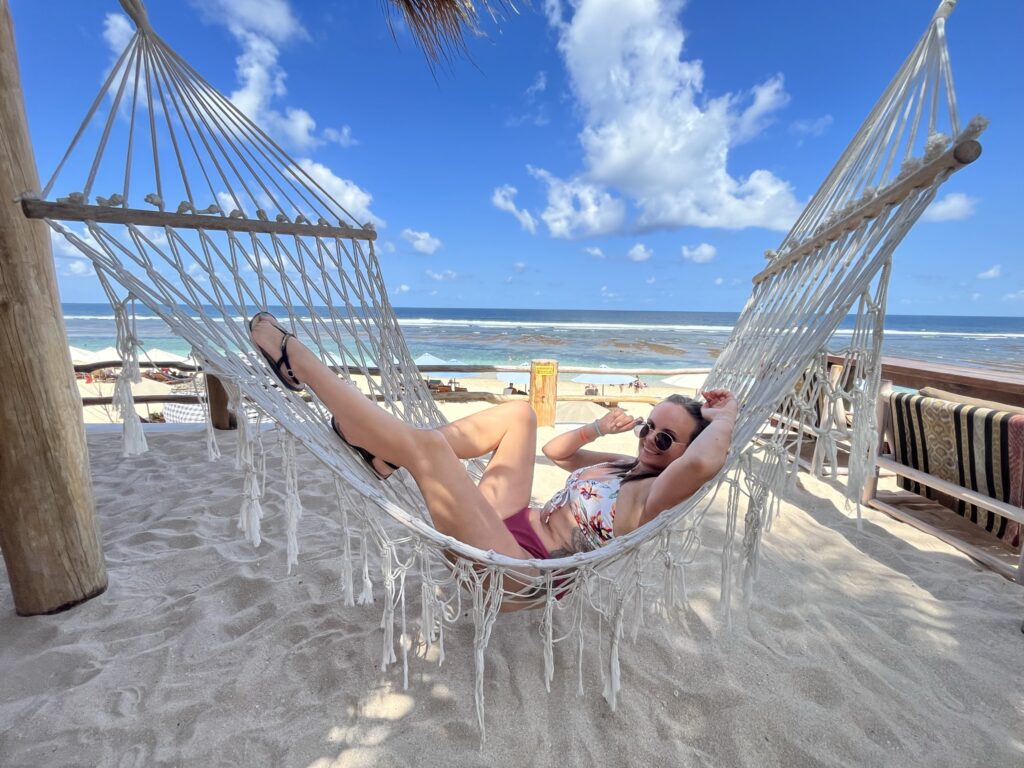
Seminyak – Shopping, Dining, Beach Clubs
Seminyak is Bali’s urban beach town—boutiques, craft cocktails, international cuisine, and beach clubs right on the sand. It’s walkable, stylish, and great for first-timers. But it’s also busy, with more traffic and open-ocean waves that aren’t ideal for casual swimming. Still, it makes a great landing pad.
💡 Ellis’ Tip: Start your trip here for two nights, then move to a quieter base once you’ve adjusted.
Sidemen – Quiet Valley, Rice & Agung Views
Sidemen is Bali without the buzz. Mornings here are silent except for birds and rustling palms, with Mount Agung watching from the horizon. It’s perfect for slowing down, doing yoga, and walking through living rice landscapes. Nightlife is minimal, but the peace is unforgettable.
💡 Ellis’ Tip: Ask locals for cafés with Agung views—you’ll be rewarded.
Munduk & North Bali – Waterfalls, Eco-Lodges, Fewer Crowds
North Bali feels like a world apart. The air is cooler, the roads wind through jungle hills, and waterfalls like Sekumpul and Banyumala wait at the end of muddy trails. Munduk is ideal for hiking, nature, and a mid-trip reset. It’s quieter, less developed, and still deeply authentic.
💡 Ellis’ Tip: Link Lovina, a dolphin sunrise, and a waterfall circuit with a night in Munduk for the perfect loop.
Nusa Penida – Cliffs, Coves, Day-Trip Darling
Nusa Penida is wild and unforgettable. Once difficult to reach, it’s now just a fast boat from Sanur, with roads that still feel raw and views that steal your breath. Stay overnight to catch sunrise without the crowds, and don’t miss Kelingking’s “T-Rex” cliff or Diamond Beach. The island is still rough around the edges—but that’s part of its charm.
💡 Ellis’ Tip: Stay one night. Sunrise and late afternoon are when the magic happens.
What to Do – Our Personal Highlights (and How to Time Them)

Dolphin Sunrise in Lovina
⏰ Best time: 06:00 | 🎯 Tip: Ask for private boat
We set our alarm for 4:30 a.m. and stumbled, still half asleep, down to the beach with coffee in hand. By 6:00 a.m., our little boat was gliding over calm water. Suddenly, dozens of dolphins appeared, leaping across the horizon, with pink light dancing on the sea and nothing but the sound of wind and fins. It was early, and absolutely worth it.
It was so beautiful and overwhelming that we both had tears in our eyes. We had a private guide just for us, which made all the difference. There were already a few boats around, and following the dolphins can feel a bit uncomfortable, but it never felt like a chase. It was more like quietly searching for where they might show up next.
After that, it was time for snorkeling. Because of our private guide, we got into the water a little earlier and reached the reef before anyone else. For a magical moment, it was just us, alone with the ocean, surrounded by colorful fish and silence.
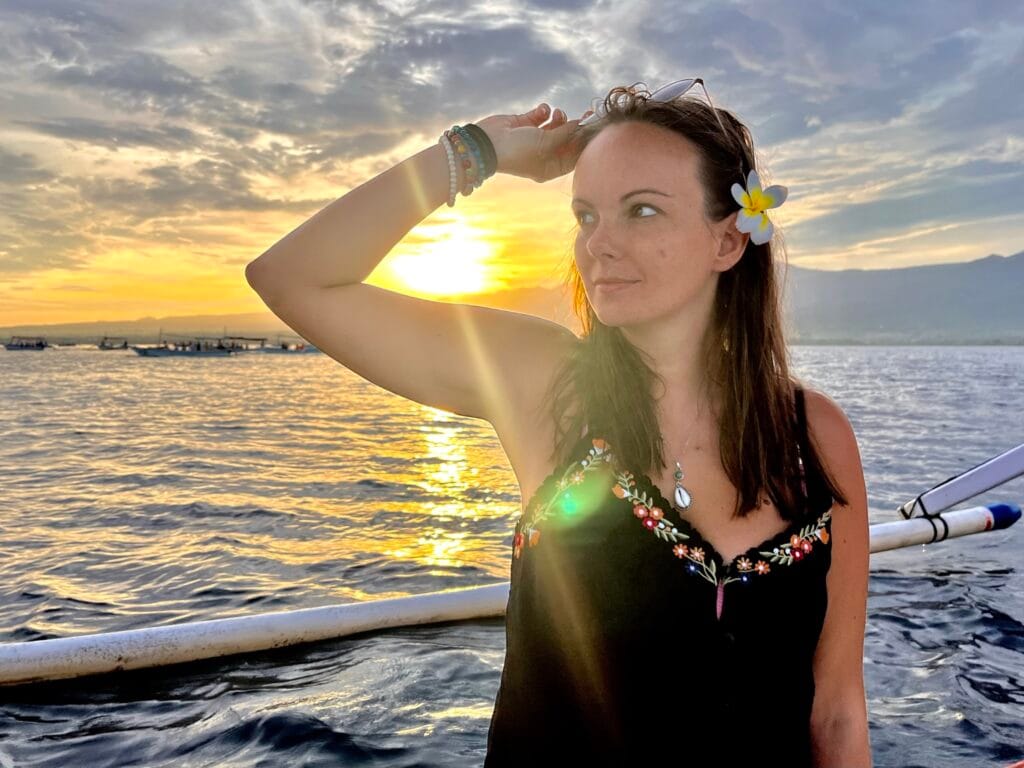
Morning Walks near Ubud
⏰ Best time: 07:00–08:00 | 🌿 Tip: Let your guide show you
We started just after sunrise, following our guide Wayan through what he called a shortcut. It turned into an unexpected adventure across Ubud’s famous rice terraces. The path was narrow and sometimes a little slippery, but every turn opened up to breathtaking views of endless rice fields.
💡 Mario: “There were moments when we had to balance carefully along the edges, but each view was more stunning than the last.”
Why you shouldn’t miss it:
- Authentic encounter with local farmers and rice cultivation
- Spectacular views perfect for photography
- Peaceful environment, far from tourist crowds
ℹ️ If you want to dive deeper into the magic of Ubud, check out our full story here: Unveiling the Spiritual Heart of Ubud, Bali .
Tegallalang Rice Terraces
⏰ Best time: Opening or late afternoon | ☀️ Avoid: Midday heat
We were a little sceptical at first – would this be just another tourist trap? But arriving right at opening time changed everything. The golden morning light touched the paddies, the air was quiet, and for a while we had the terraces almost to ourselves.
What many people don’t realize: there are several entry points, not just one. And if you’re willing to walk a little further than most visitors, you’ll find yourself surrounded by stretches of rice fields that feel almost untouched. It’s peaceful, it’s authentic, and the photo opportunities are incredible.
Uluwatu Temple & Kecak Fire Dance
⏰ Best time: Last show at sunset | 🎟️ Tip: Book seats in advance
As the chanting began and the sky turned orange, it felt like time slowed down. The Kecak performance was pure island magic, echoing ancient rhythm on the cliffs. Stay a few minutes after and you’ll see the most stunning sunset colors.
🐒 Attention: Watch out for the monkeys. They are quick, clever, and will grab anything that isn’t secured. Phones, sunglasses, even water bottles vanish in seconds. Keep your belongings locked away or firmly attached to you. It might feel funny at first, but losing your phone to a monkey is no joke.
Best Time to Visit (and How It Feels)
Bali runs on two moods: dry season brings blue skies and steady winds; green season turns the island vivid with short, heavy showers. With the right timing, both can be wonderful.
☀️ Dry Season · Apr–Oct
- Feels like: bright mornings, lower humidity, easier roads
- Why go: beach weather, reliable sunsets, clearer volcano views
- Watch for: July–Aug peak; book Uluwatu, Canggu & Nusa Penida early
- Suits: first-timers, families, west-coast surf, island-hopping
🌧️ Green (Rainy) Season · Nov–Mar
- Feels like: lush rice fields, warm air, quick afternoon downpours
- Why go: quieter sights, better waterfalls, lower prices
- Watch for: slick terrace paths; occasional west-coast debris after storms
- Suits: photographers, temple/waterfall focus, value travelers
🎎 Festivals & Culture
Nyepi (Day of Silence) in 2025 falls on Saturday, March 29, from 6 a.m. until 6 a.m. on March 30. The entire island shuts down—no travel, lights, or street activity. On the eve, join the Ogoh-Ogoh parades, where giant statues are carried through the streets in a dramatic display before silence begins.
Galungan & Kuningan: streets lined with penjor bamboo poles and family ceremonies; some shops run shorter hours.
💡 Our take: We love May for vivid fields, calmer seas, and bearable heat. Late September is another sweet spot: dry, golden light, fewer crowds. Green season is underrated if you’re temple and waterfall focused.
🧭 Quick Picker by Interest
- Surf: West coast/Bukit shine in dry; east coast (Sanur, Nusa Dua) cleans up in green season.
- Diving: Manta rays year-round (Nusa Penida); mola mola most likely Jul–Oct (cooler water).
- Waterfalls: Fullest Dec–Mar after rain; go early with grippy shoes.
- Fast boats: Smoothest May–Jun & Sep; choppier with strong winds/storms.
- Rice terraces: Brightest green a few weeks post-planting; “golden” before harvest (varies by area).
🗓️ Month-by-Month (quick read)
- Jan–Feb: warm, wet, lush; great waterfalls; seas can be stormy
- Mar: late green season; Nyepi often falls now
- Apr: shoulder; sunnier days return, seas steadying
- May: sweet spot; green landscapes, calm seas, fewer crowds
- Jun: sunny, pleasant, island-hopping
- Jul–Aug: peak energy; west-coast surf; book ahead
- Sep: dry, golden light, fewer crowds
- Oct: warmer, some showers; still good beach days
- Nov–Dec: greener, afternoon showers; quieter prices pre-Christmas; late Dec busy
Best Beaches in Bali (What They’re Really Like)
There are countless beaches in Bali, each with its own charm. This is our personal list of the very best. Think cliff backed coves in Uluwatu and sunset shores in Seminyak and Jimbaran. You will find calm bays for swimming, surf breaks for beginners and pros, and family friendly runs of golden sand. When you want quiet, slip to black sand stretches in Canggu or the photogenic white sand of Melasti, Padang Padang, and Pandawa. Time it right and you may have them almost to yourself.
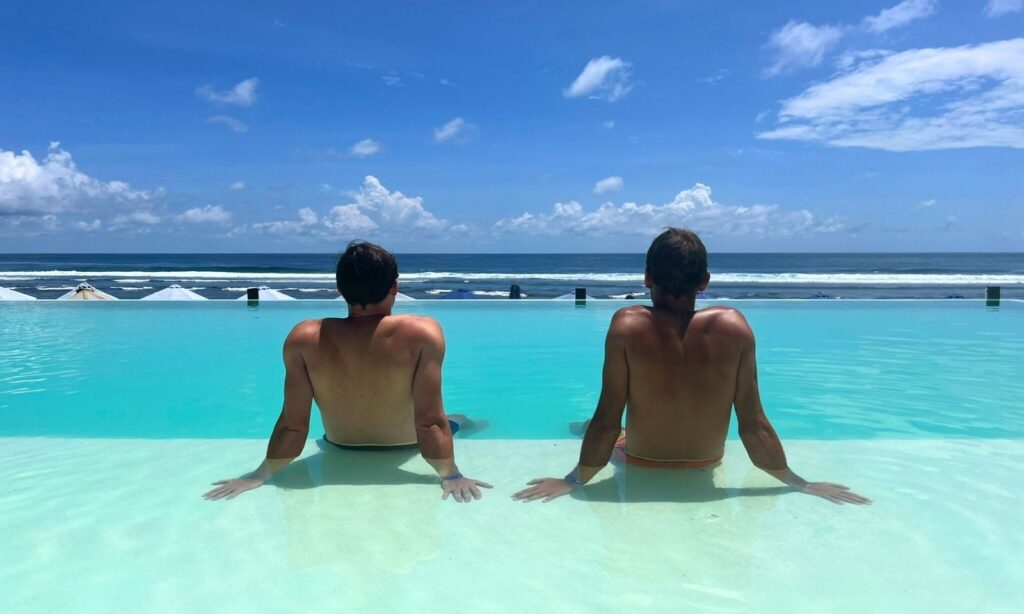
Jimbaran Beach
Jimbaran is a wide crescent of soft sand with gentle water and rows of seafood warungs set directly on the beach. It is best at golden hour when you can sit down for dinner and watch planes lift off across the bay. The water is usually calm enough for swimming and evenings are the highlight.
Canggu Beaches: Batu Bolong, Berawa, and Echo
Canggu’s coastline is dark sand with rolling surf and a lively international scene. Batu Bolong is popular with learners, Berawa attracts beach clubs, and Echo Beach offers moodier sunsets and a quieter stretch of sand. The surf can be strong and currents unpredictable, so these beaches are better for surfing than for casual swimming.
Seminyak Beach
Seminyak is the center of Bali’s sunset scene with beanbags, cocktails, and a relaxed promenade atmosphere. Waves here are more suited to surfing than to safe swimming. The beach is best for people-watching and enjoying the evening light.
Kuta Beach
Kuta is long, sandy, and forgiving, which makes it ideal for beginners. Surf schools line the shoreline and lessons are easy to arrange on arrival. It is busy and commercial but still one of the most family-friendly beaches for a first experience on the board.
Green Bowl Beach
Green Bowl is a turquoise pocket beneath high limestone cliffs, reached by a steep staircase. The cove is best on calm days at mid or low tide. Currents are strong when the swell rises, but snorkeling can be excellent when the water is clear and still.
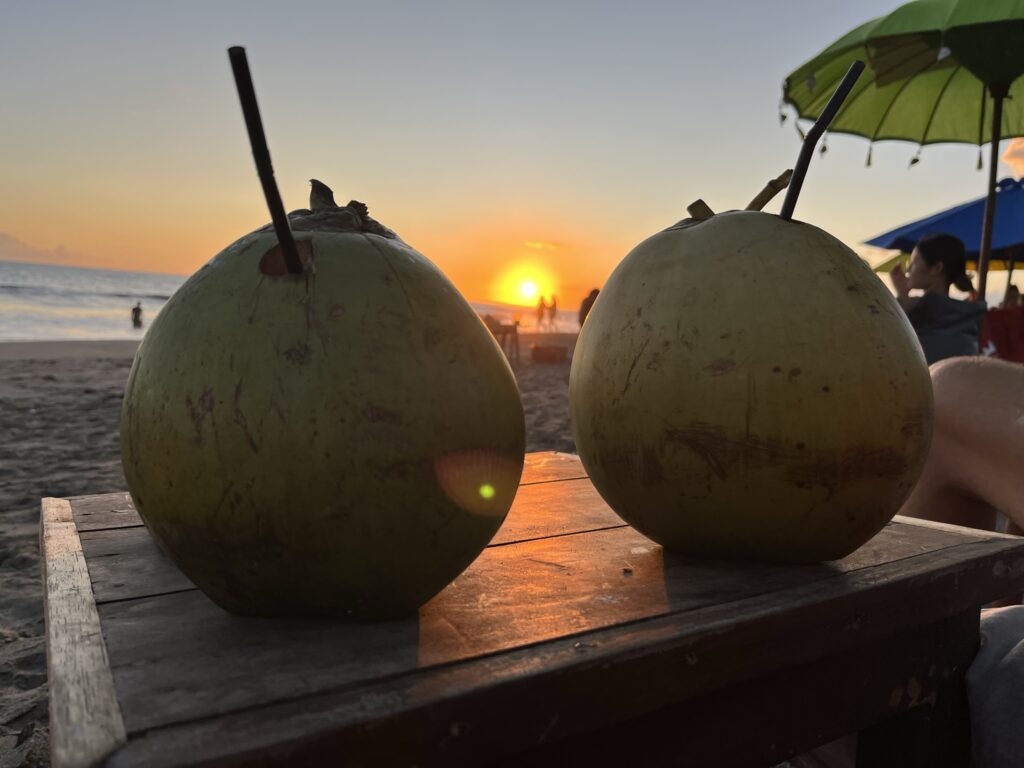
Padang Padang Beach
Padang Padang is a small and photogenic cove entered through a narrow rock gate, famous from the film Eat Pray Love. The inner bay can be pleasant for swimming around mid tide. The outer reef is a powerful surf break reserved for experienced surfers. Early morning is the best time to visit before it becomes crowded.
Thomas Beach
Thomas Beach sits between Padang Padang and Uluwatu, down a long staircase that keeps it quieter than many other spots on the Bukit. The sand is soft and white, and the water can be calm enough for swimming when conditions allow. Small cafés and warungs offer simple meals and drinks, giving it a relaxed, local feel. It is a good choice for visitors who want fewer crowds and a laid-back setting.
Pandawa Beach
Pandawa is known for clear water, a broad sandy shelf, and easy entry, which makes it very suitable for families. Facilities are organized and the access road cuts dramatically through the cliffs. Weekday mornings provide the most space and a quieter atmosphere.
Melasti Beach
Melasti in Ungasan combines white sand, calm clear water, and a backdrop of high cliffs. Several relaxed beach clubs sit directly on the sand. It is one of the best options for safe swimming and relaxed afternoons, with mornings offering the quietest setting.
Plan Bali Without Stress
Get our Bali Travel Guide 2025 – 30+ pages of real tips from 6+ months on the island.
📥 Download the Guide
Exploring Beyond Bali: Islands Worth the Trip!
Bali is only one of more than 17.000 Indonesian islands. A few neighbors sit close enough for an easy side trip of two to four nights by fast boat. If you’re planning a trip to Bali and don’t know where to start, what to skip, or how to structure it all, our 3 week Bali itinerary can help you plan with ease.
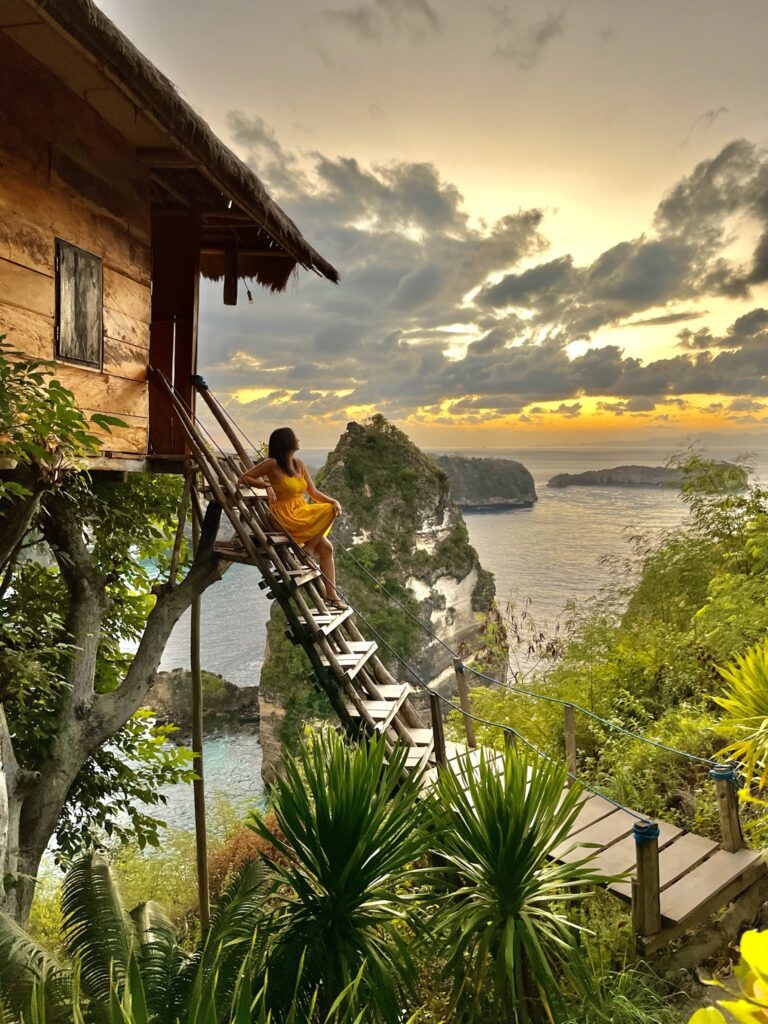
Nusa Lembongan & Nusa Ceningan
Nusa Lembongan and Nusa Ceningan are about 30 minutes from Sanur. Think calm lagoons, simple beach cafés, and the Yellow Bridge that is exactly as Instagram promised. Tides shape the beaches, evenings stay quiet, and families breathe easier. It feels like Bali before the algorithm found it. Two to three nights do the job.
Nusa Penida
Nusa Penida is the dramatic choice. Kelingking’s T-Rex cliff steals the show, manta ray snorkeling is the headline, and viewpoints like Rumah Pohon and the Thousand Islands Bay fill the camera roll. Boats from Sanur take around 40–50 minutes. Roads can be rough and currents are often strong, so many beaches are not safe for casual swimming. Stay one night to enjoy sunrise and sunset without the day-trip stampede. Yes, the stairs are real and your legs will notice.
Gili Islands
The Gili Islands sit off Lombok and you reach them in about 2–3 hours from Padang Bai or Amed, with some services from Sanur or Serangan. There are no cars, which is fine because you can cross an island by bicycle faster than you can find parking in Canggu. Expect white sand, clear water, and easy turtle snorkeling. Gili Trawangan is lively, Gili Air is balanced, and Gili Meno is quiet.
Quick rule of thumb: pick Lembongan and Ceningan for the simplest hop and an easy pace, choose Penida for cliffs, mantas and Instagram, and head to the Gilis for car-free island life on bright sand, crowded bars, and the party that never ends.
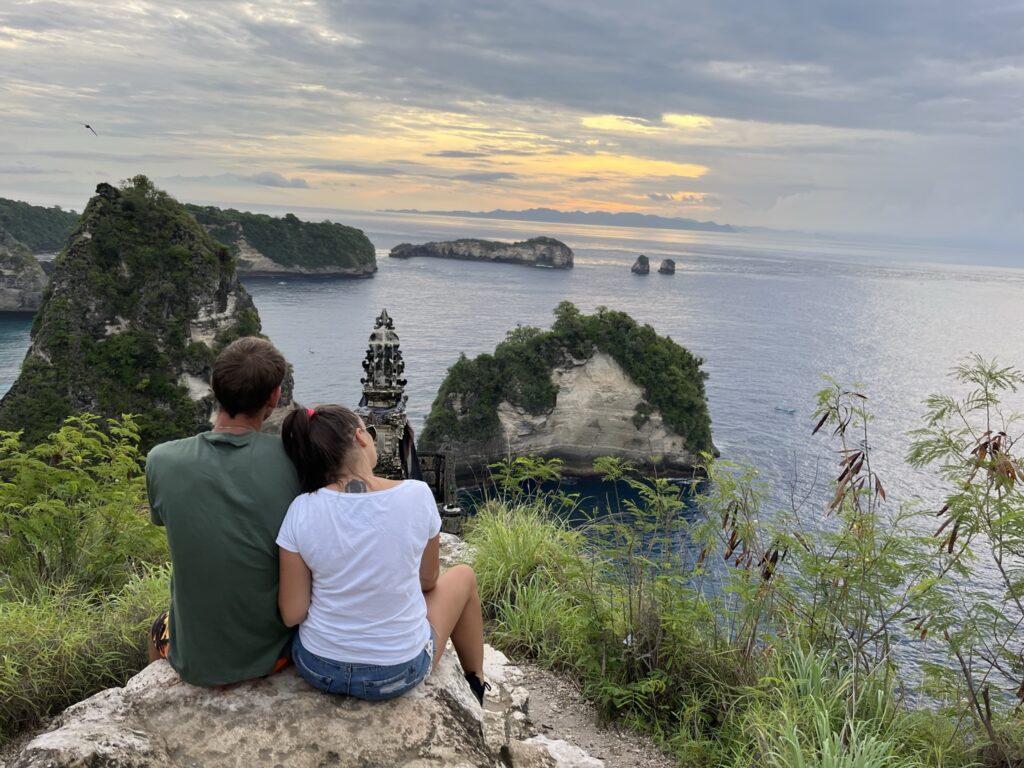
Eating in Bali: Where to Find the Best Food
Bali’s food scene ranks among the most exciting in Asia. From family-run warungs serving fragrant nasi goreng for just a euro to shared Italian feasts in Canggu, the island serves flavors for every budget and mood.
Eat Local – The Warung Experience
For real flavor and unbeatable value, follow the locals. A plate of nasi goreng or mie goreng at a simple warung costs only 20,000–50,000 IDR (€1–3). These tiny kitchens capture the soul of Balinese cooking in a way beach clubs never can.
💡 Tip: Arrive before noon. Most warungs cook fresh in the morning and sell out by late afternoon.
Our Favorite Restaurants
Milk & Madu Best for Sundays
Famous for brunch and strong coffee, and even better for its 2 for 1 pizzas every Tuesday and Sunday, 4 p.m. to 10 p.m. A lively spot with an easy vibe that works well for families and groups.
Sa’Mesa Special Occasions
A dining concept inspired by the Italian tradition of La Nonna Carmela. More than 18 courses are served family style at one long table, where strangers quickly become friends over free-flowing limoncello. It was one of our most unforgettable Bali nights.
Lola’s Casual Mexican
Bright, colorful, and easy to reach from anywhere in Canggu. Tacos, bowls, margaritas—our go-to spot when we want a relaxed evening with good flavors.
Western Cafés & Global Choices
In Seminyak, Canggu, and Ubud you will find countless cafés serving smoothie bowls, plant based dishes, and gourmet burgers. Expect to pay 100,000–250,000 IDR (€6–15) per main dish, and more in upscale restaurants.
Delivery Apps
Too tired to go out? Grab and Gojek deliver almost anything straight to your door—from local rice boxes to sushi and even groceries. Perfect for rainy nights or lazy mornings.
📝 Good to know: Tipping isn’t mandatory. If no service charge is included, 5–10% is customary but not required. For delivery drivers, just rounding up is always appreciated.
Top 5 Warung Dishes to Try
- Nasi Campur Bali. A sampler plate: rice with small portions of vegetables, sambal, tempeh, shredded chicken or fish, and sometimes pork. Go before noon for the widest choice. (IDR 20,000–50,000)
- Sate Lilit. Minced fish or chicken mixed with coconut and spices, shaped on lemongrass sticks and grilled; juicy and smoky. (IDR 15,000–35,000 per portion)
- Babi Guling. Roast suckling pork with crackling, lawar, rice, and sambal. Morning dish; best at traditional spots. Not halal. (IDR 40,000–70,000 per plate)
- Lawar (or Urap). Chopped vegetables with grated coconut, herbs, and spices. Ask for lawar putih (no blood) or say tanpa darah. Urap is a good vegetarian alternative. (IDR 15,000–30,000)
- Bebek Betutu. Slow-cooked duck with Balinese spices, traditionally wrapped in banana leaves; celebratory and deeply flavored. Some places require pre-order. (IDR 70,000–120,000 per person)
💡 Ordering smart. For milder spice, say tidak pedas. If you avoid pork, ask for halal options (many warungs serve chicken or fish only). Bring small cash; some accept local QR payment, but not all.
Allergy note: Sambal and some sauces may include shrimp paste (terasi). Ask if unsure.

Important Tips for a Great Bali Experience
Avoid Tourist Traps: Skip the big group tours and book a private driver or guide instead. It’s often not much more expensive, and you’ll avoid the crowds while enjoying a more flexible and personal experience.
Explore Different Areas: Don’t just stay in one place. Bali is incredibly diverse – from the cultural heart of Ubud to the surf cliffs of Uluwatu, the hidden waterfalls in the north, and the diving paradise of Amed. Each region feels like a different island waiting to be explored.
Respect Local Customs: Balinese culture is deeply spiritual. Dress respectfully when visiting temples (cover shoulders and knees), never step on offerings placed on the ground, and always smile – kindness goes a long way here.
Start Early: Whether it’s watching dolphins, hiking Mount Batur, or visiting famous temples, going early means fewer crowds, cooler temperatures, and magical light for photos.
Stay Hydrated & Sun-Safe: The tropical sun is strong. Always carry water, use reef-safe sunscreen, and take breaks in the shade to keep your energy up.
Get a SIM or eSIM: Internet is essential for navigation and bookings. A local Telkomsel SIM or an Airalo eSIM works great and is affordable.
Try the Local Food: Beyond smoothie bowls and Western cafés, dive into authentic Balinese cuisine – Nasi Campur, Babi Guling, Satay, and fresh seafood on the beach. These meals are often the most memorable.
Embrace the Pace: Things in Bali don’t always run on strict schedules. Roads get busy, weather shifts quickly. Take it slow, go with the flow, and you’ll enjoy the island so much more.
Cash is Still King: While many cafés and hotels accept cards, smaller shops, markets, and drivers often prefer cash in rupiah. ATMs are common, but don’t forget to withdraw ahead of time if you head into rural areas.
Mind the Monkeys: At temples like Uluwatu or Monkey Forest, the monkeys are cheeky and will grab anything loose – sunglasses, bottles, even phones. Keep your things close.
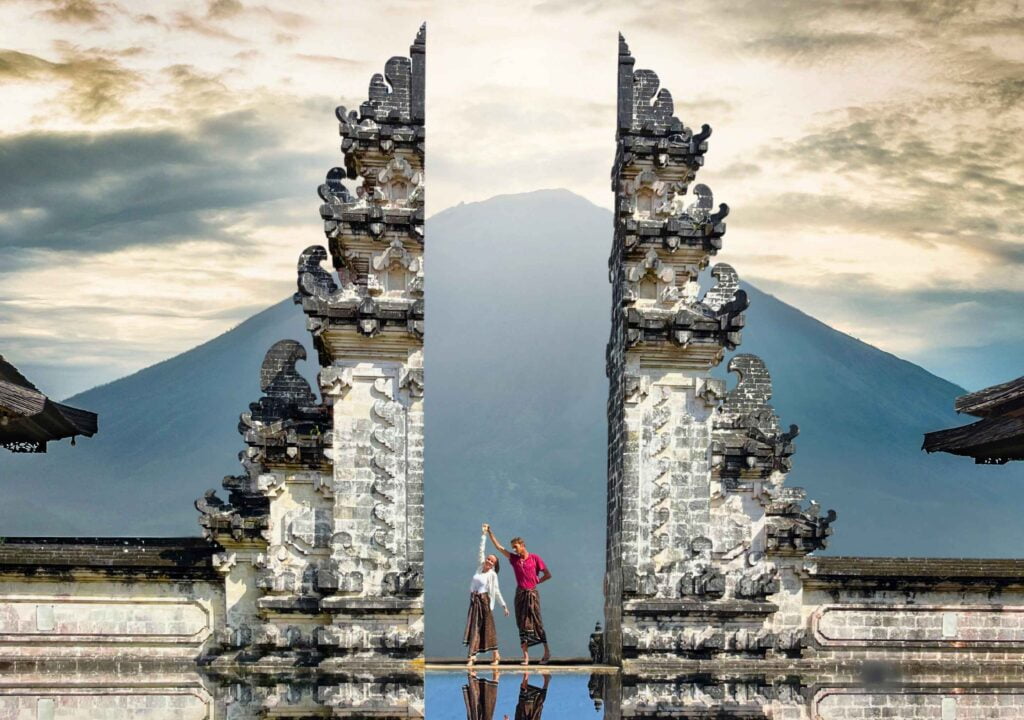
Money Matters in Bali: Managing Your Finances
Even though credit cards are widely accepted, it’s always smart to carry some cash in Bali. Here are a few tips to keep your money safe and your trip stress-free:
Stick to Reliable ATMs: Use machines from national banks like BCA or Mandiri. They’re safer, less likely to have skimming devices, and more dependable when withdrawing larger amounts.
Consider a Multi-Currency Card: Travel cards such as Wise are excellent for Bali. They offer fair exchange rates, low fees, and make it easy to manage different currencies. If you’re staying longer, they’ll save you money compared to constant ATM withdrawals or currency exchanges.
Use Cash for Local Experiences: While hotels and big restaurants take cards, many small shops, warungs, and market stalls prefer cash in rupiah. It’s also best for tipping drivers, guides, and staff. Having cash on hand ensures you don’t miss out on authentic local moments.
💡 Extra Tip: Always carry smaller bills. Vendors often don’t have change for large notes, and it makes quick purchases smoother.
What Bali really costs – an easy breakdown
| Backpacker | Mid-Range | Luxury | |
|---|---|---|---|
| Accommodation | 100.000–200.000 IDR (~€6–12) dorm bed | 500.000–1.500.000 IDR (~€30–90) boutique/3★ | 2.500.000+ IDR (€150+) villa/resort |
| Meals | 20.000–50.000 IDR (~€1–3) warung | 100.000–250.000 IDR (~€6–15) café/restaurant | 350.000–1.000.000+ IDR (~€20–60+) dining |
| Transport | 70.000–120.000 IDR/day (~€4–7) scooter | 50.000–150.000 IDR/ride (~€3–9) Grab/Bluebird (short hops) | 650.000–900.000 IDR/day (~€38–53) private driver (8–10h) |
| Activities | 15.000–50.000 IDR (~€1–3) temples/sights | 800.000–1.400.000 IDR (~€47–82) diving/snorkel | 1.200.000–2.500.000+ IDR (~€70–150+) private tours |
| Sample Daily Budget | 600k–900k IDR (~€35–53) dorm + 2× warung + coffee + scooter + sight | 1.4m–2.2m IDR (~€82–129) boutique room + warung lunch + café dinner + 2–3 rides + activity | 3.5m+ IDR (€200+) villa + driver day trips + fine dining/private experiences |
💡 Tipping: Not mandatory. If no service charge is added, 5–10% is appreciated. For drivers, rounding up is common.
Extended FAQs (2025)
Do I need a visa?
Yes. Most travelers enter with a 30-day Visa on Arrival (~500,000 IDR / €30) and can extend once to 60 days. For longer stays, apply in advance for a B211A visa (up to 180 days).
How much does a trip cost per day?
Backpackers typically spend 500,000–800,000 IDR (€30–50) per day, mid-range travelers 1.2–2.5 million IDR (€80–150), and luxury visitors 3.5 million IDR (€200+) or more.
Is Bali safe?
Yes. With basic road caution, good hygiene, and a valid international driving permit if you ride a scooter, Bali is generally safe for travelers.
Can I drink tap water?
No. Stick to bottled or filtered water. Many hotels and villas provide refill dispensers.
Grab or Gojek?
Both apps work well. Gojek is usually cheaper for short hops and food delivery, while Grab is reliable for airport transfers and longer rides.
Can I pay by card?
Yes, in cafés and hotels—though some add a 2–3% fee. In local warungs and markets, cash is still expected.
Do I need vaccines?
Consult your doctor before traveling. Common recommendations for Bali include Hepatitis A and Typhoid. Make sure your tetanus shot is up to date.
How do I avoid “Bali belly”?
Eat cooked foods, peel fruit, avoid ice from unknown sources, and wash or sanitize your hands regularly.
Where can I swim safely?
Uluwatu and the Bukit Peninsula have calmer bays like Padang Padang, Melasti, and Thomas Beach. West-coast beaches near Canggu often have strong currents—follow flags and lifeguards.
Is Bali good for digital nomads?
Yes. Canggu, Pererenan, and Ubud offer coworking spaces, plenty of cafés, and long-stay apartments.
How do I respect the culture?
Cover shoulders and knees in temples, wait patiently during ceremonies or road closures, and never move or step on daily offerings.
In Conclusion: What It Takes to Experience a Memorable Trip to Bali in 2025

Bali keeps evolving, providing contrasts between ancient traditions and contemporary luxuries. The island contains diverse terrains, lively cuisine, beautiful beaches as well as distinct adventures that suit all types of people. Regardless of whether you desire secluded locations or the lavish comfort found in high-end hotels or want to simply discover the depth of culture interwoven with this island, there’s no doubt your journey will be a memorable one.
The island isn’t perfect. Our first ten days left us cold. But somewhere between a quiet valley in Sidemen and the shimmer of a Lovina sunrise, Bali became a place we return to. If you come with patience and curiosity, it might do the same for you.


